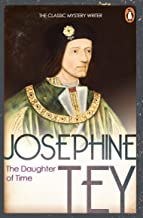Josephine Tey straddled two genres with her The Daughter of Time in 1951: crime fiction meets historical novel. Of course others have done this since in different styles: Ellis Peters and CJ Sansom to name but two. But when I first discovered it (I think someone mentioned it at school) in the 1960s, I was intrigued by the whole concept. I was used to Jean Plaidy and Agatha Christie – but not in the same book.
Time for a revisit. Tey’s detective, Inspector Alan Grant, who features in several novels is flat on his back in hospital with a broken leg. Given a photograph of Richard III by a friend he becomes fascinated by the mystery of the Princes in the Tower. They disappeared and although there was a confession from a man (fall guy?) named Tyrell, the truth has always been elusive. With the help of an outstandingly competent young researcher and several books, Grant sets out to solve the 400 year old mystery. Were the boys actually killed and, if so, whodunit?
The novel is a good read but never let it be forgotten that this is fiction. Some of the source books Grant relies on are fictional too. And as soon as Thomas More’s writings about Richard were mentioned, alarm bells rang in my head because he was not a contemporary. Grant initially thinks he was but, eventually, realises that More was merely producing malicious hearsay between 1515 and 1518 (Richard died in 1460) for propaganda purposes, and comes to loath “the sainted More”.
Of course Tey manipulates the evidence to convince the reader (if s/he hasn’t got bogged down in Plantaganet family history and lost track) that Richard was a kindly man who couldn’t possibly have given the order to murder his nephews. It’s an interesting thesis. Grant, like all the best fictional detectives, is a pleasant man to spend time with and I love the character of Brent Carradine – a young American. He has persuaded his wealthy manufacturer father that he has to be in London to carry out research in the British Library. Actually he wants to be with his actress girlfriend. Grant’s all absorbing research is just what he needs. He will now write a book and avoid for ever the fate of having to go into the dreaded family business.
There’s now another slant on all this. Grant, Carradine and maybe their creator Josephine Tey are convinced that the posthumous presentation of Richard as a crippled monster was Tudor propaganda, well oiled by one William Shakespeare. Then, in 2012, astonishingly, Richard’s remains were found beneath a car park in Leicester. And guess what? The skeleton, of which we all saw photographs, showed clear evidence of scoliosis. So he really was a “hunchback”. But that, of course, does not make him guilty of infanticide. So the mystery remains.
Tey’s novel is a gripping period piece but, like all historical novels, needs to be read with cautious scepticism.
Next week on Susan’s Bookshelves: The Winthrop Woman by Anya Seyton
